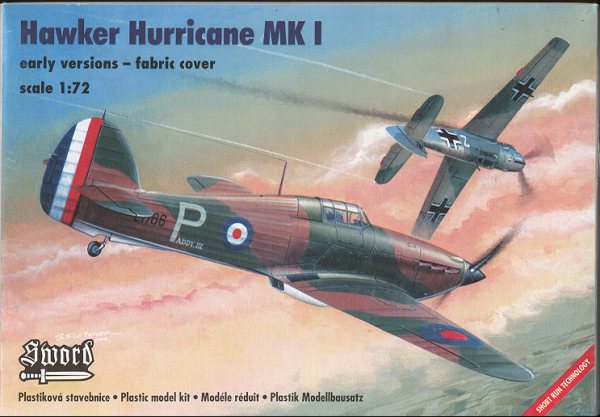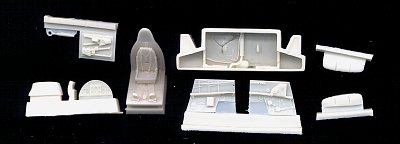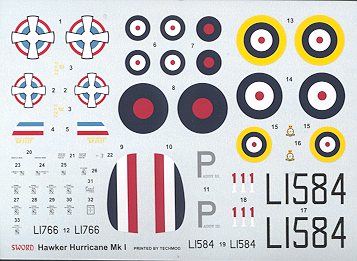
|
KIT: |
Sword 1/72 Hurricane I 'Early' |
|
KIT # |
72012 |
|
PRICE: |
$17.989 |
|
DECALS: |
Three aircraft |
|
REVIEW & |
|
|
NOTES: |
Short run with vac and resin bits |

|
HISTORY |
Britain's first modern low-wing monoplane fighter was the Hurricane. Initial production versions were in many ways similar to the biplanes that it replaced. Tubular frame construction covered with fabric with metal panels near the cockpit and engine area were typical biplane construction. So was a wooden fixed pitch prop. What wasn't the same was the retractable landing gear or the eight gun armament. The Hurricane was designed to knock down an enemy by pumping as many bullets into it as possible. The fact that they were rifle caliber wasn't a problem as most planes of the time had minimal armor plating.
The Hurricane was quite a well liked aircraft as it was not only easy to fly, but it was fast and chicks dug guys who flew it! However, aeronautical progress was such that it was no longer king of the air by the time war broke out in 1939. That was taken by the Spitfire and the chicks had already split for those pilots! The Hurricane wasn't finished by any means and was continually modified until production stopped in 1944. What it was well known for was its ability to take a lot of punishment and still bring back the pilot. It was also an easy plane to build. It was this high rate of production that meant that the Hurricane provided the bulk of RAF fighter aircraft for the early war years.
|
THE KIT |

Some time back I was bemoaning the lack of a fabric winged Hurricane. After a number of e-mails set me straight, I ordered this Sword kit of the Hurricane I. I was warned that it would be a challenge to build. We'll see. The kit is 'typical Czech short run'. This means rough edges to the parts, some flash, large ejector pins on large parts, no alignment pins, resin parts and vacuformed canopy. No problem for those who consider themselves intermediate modelers. One thing I did notice was that some of the parts were misaligned. Particularly bad was the fin. We'll have to see how that plays out in construction.
This particular kit has a number of options. One is that there are three different propellers available. Early fabric winged Hurricanes were often retrofitted with the newer props. It also has the under fuselage strake near the tail wheel as an optional part. Very early Hurricanes didn't have this part. You also get two types of exhaust; the regular 'ejector' type and the 'kidney' versions.
 Resin is used for the cockpit, wheel
wells, intakes, kidney exhaust, instrument and side panels. My wheel well had a
molding flaw that distracted from the very nice looking well. Sword was kind
enough to provide two vac canopies for us who need two. The packaging was quite
good with the plastic, resin and decals all in separate bagged sections.
Resin is used for the cockpit, wheel
wells, intakes, kidney exhaust, instrument and side panels. My wheel well had a
molding flaw that distracted from the very nice looking well. Sword was kind
enough to provide two vac canopies for us who need two. The packaging was quite
good with the plastic, resin and decals all in separate bagged sections.
The instructions are a bit different from the usual. There are several exploded
construction sequences. Detail instructions are given for  things like the props, wheel wells, landing gear
and interior construction. Color information is given in generic colors. Decals
are superb and produced by Techmod. This means they will be very thin and fit
well. They are crisp and in register. Three different aircraft are on the sheet.
One is a Jugoslav built version in their own unusual camo scheme of dark green,
sand, and dark brown over light blue. Two are RAF versions. The first is from
the first squadron to fly the plane, 111sq in its prewar colors and markings
with huge under wing serials. The instructions state the proper upper colors,
but give sky for the lower color. I'm wondering if it should be aluminum or not.
The other RAF Hurricane is one flown by 'Cobber' Kane in France during
1940. This one is complete with rudder stripes and white/night under wing
colors. All three schemes are quite attractive and it will be difficult to
choose which to use!
things like the props, wheel wells, landing gear
and interior construction. Color information is given in generic colors. Decals
are superb and produced by Techmod. This means they will be very thin and fit
well. They are crisp and in register. Three different aircraft are on the sheet.
One is a Jugoslav built version in their own unusual camo scheme of dark green,
sand, and dark brown over light blue. Two are RAF versions. The first is from
the first squadron to fly the plane, 111sq in its prewar colors and markings
with huge under wing serials. The instructions state the proper upper colors,
but give sky for the lower color. I'm wondering if it should be aluminum or not.
The other RAF Hurricane is one flown by 'Cobber' Kane in France during
1940. This one is complete with rudder stripes and white/night under wing
colors. All three schemes are quite attractive and it will be difficult to
choose which to use!
|
CONCLUSIONS |
I'm really rather psyched about this kit. I have wanted a fabric winged Hurricane for quite some time. I have also never built a Sword kit, but judging from the results that Alan Wanta got from his Vought V-173 reviewed here a while back, it should be a nice one.
Review kit courtesy of me and my wallet!
If you would like your product reviewed fairly and quickly by a site that has thousands of visits a day, please contact me or see other details in the Note to Contributors.